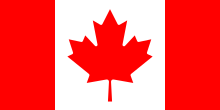 | |
| Data | |
|---|---|
| Water coverage (broad definition) | 100% |
| Sanitation coverage (broad definition) | 100% |
| Share of collected wastewater treated | 97% |
| Continuity of supply | 100% |
| Average urban water use (L/person/day) | 343[1] |
| Share of household metering | 56% (1999) |
| Annual investment in WSS | n/a |
| Share of self-financing by utilities | partial |
| Share of tax-financing | partial |
| Share of external financing | none |
| Institutions | |
| Decentralization to municipalities | Full |
| National water and sanitation company | No |
| Water and sanitation regulator | Yes, in some provinces |
| Responsibility for policy setting | Department of Environment and Department of Health |
| Sector law | No (only for water resources) |
| No. of rural service providers | n/a |
Water supply and sanitation in Canada is nearly universal and generally of good quality, but a lack of clean drinking water in many First Nations communities remains a problem.[2] Water use in Canada is high compared to Europe, since water tariffs are low and 44% of users are not metered.
Despite a commitment by the federal government to promote increased cost recovery, only 50% of the cost of maintaining and operating water infrastructure is actually being recovered from users through tariffs, the rest being financed through taxes.
- ^ Cite error: The named reference
ec.gc.cawas invoked but never defined (see the help page). - ^ "Water in First Nations Communities". Retrieved 22 July 2019.